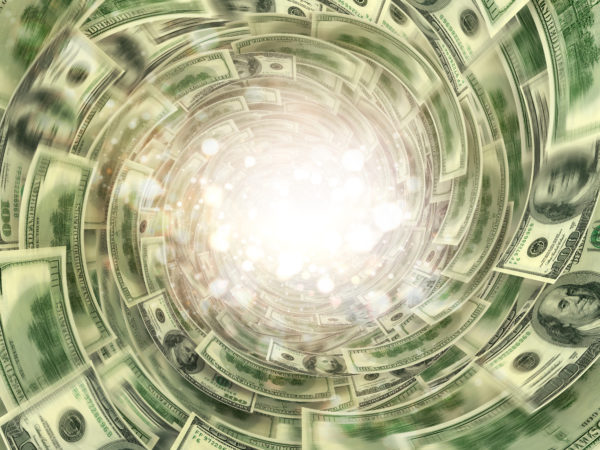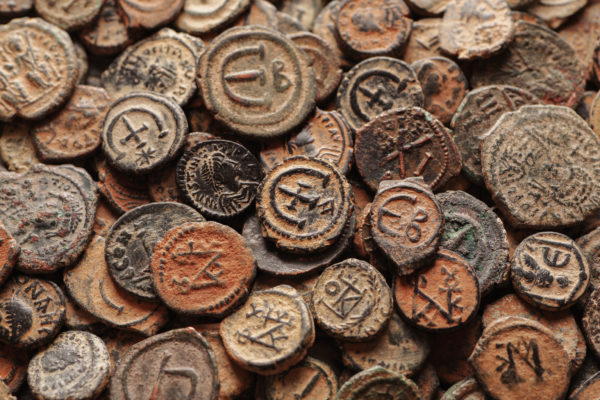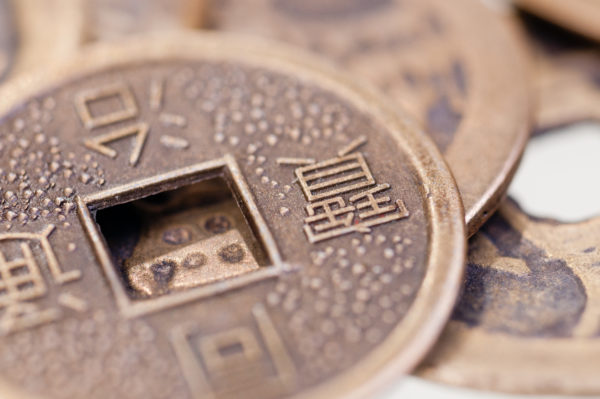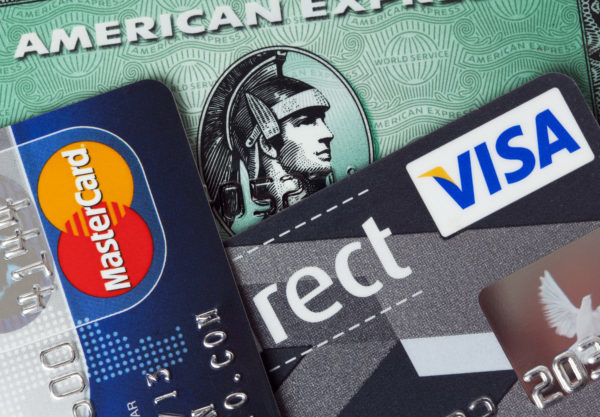Trade Is Part of Human Nature, i.e. How Did Money Come to Be?
Money is such a natural phenomenon that it has existed in some form since times immemorial. Whether money came to be ten or a hundred thousand or even a million years ago doesn’t even matter that much. What is certain, however, is that when our ancestors discovered that it’s pretty great to own things, they also gained the need to peacefully exchange items from time to time – people really couldn’t be bothered to wage war all the time. It is presumed that money came into existence due to man’s inherent instinct to do trade. Imagine that you’ve just baked some fragrant loaves of bread over hot stones, but the chilly autumn wind makes you shiver. At this very moment, a tired huntsman walks out of the forest, carrying some hide. He can smell your delicious bread. No doubt both parties will instinctively want to trade. So, you see, trade has existed in some form or other since the early days of humanity. Meat for arrowheads; an axe for beads. But what happens when it’s a hot summer day and you don’t really want those hides, contemplates author and co-author at Wired David Wolman in his book The End of Money. In that case, you’re likely to accept something valuable for your bread – something that allows you to buy hides four weeks or even four months later. This “something valuable” is money – say in the form of pretty cowry shells. So now when you took a day’s hike to a neighboring village to buy a new axe, you no longer had to drag along a cow. You’d sell that cow in your home village and buy the axe for the shells you received for the cow. Over time, a number of things have taken on the role of money – cattle, salt, feathers, hides, shells, coconuts, butter, whale teeth, cocoa seeds, tobacco leaves, etc. Another thing people soon realized was that you can’t do everything – hunt, build a house, grow crops, etc. – equally well. People began to specialize. Doctors began to cure the ill, firemen began to put out fires, cooks to cook food. Specialization boosted the economy significantly and the importance of money and trade grew. The former mythical money (shells, stones, claws, etc.) that used to grant the owner special magical powers, was replaced by value-based money, i.e. payment money, that was valuable because of the material it was made of (e.g. gold and silver). From there, it was only a small step to money becoming a medium of exchange (paper money and bank cards, where the piece of paper or plastic has little actual value). Nowadays it seems a given that money takes on several forms – cash, credit and debit cards, gift certificates, wristwatch-like devices that you can use to buy a cocktail while lounging in a pool at a spa, cryptocurrency, etc.
Nobody knows why gold once became the synonym of money and wealth. It’s likely that finding a glinting piece of gold was just something very special for our ancestors. Why else would the Incas have dubbed gold the “sweat of the sun”? Granted, the precious metal was an excellent exchange method – it doesn’t decay, burn or kill you with poisonous fumes. But long before gold coins, money used to be made from a very common material – clay. 4,000 years ago during king Hammurabi’s reign in ancient Babylon, clay tablets were used the same way we now use cash and bank cards.
Mesopotamian Clay Tablets: The First Telling Witnesses of Finance
Numerous clay tablets have been found from the areas that used to be ancient Mesopotamia. Most depict writing in cuneiform and take the form of laws or claims. Some, however, say things like “this or that much barley is to be paid to the person presenting this tablet” or “this or that much silver is to be paid to the person presenting this tablet”. In essence, we’re dealing with money. There’s also reason to believe that a system of loans based on complex compound interest was used in Mesopotamia under the rule of king Hammurabi. This is revealed by math problems from the time that include a reference to compound interest. The logic behind the calculation of interest most likely originated from the natural growth of a herd. This, however, began when people settled the area within the Tigris-Euphrates river system that would become Mesopotamia and tried their hand at irrigation agriculture and herding. The credit system was based on the good faith that the debtor would settle the debt. The common term “credit” originates from the Latin word “credo”, which means “I believe”. There’s no doubt that Hammurabi was not only a great military leader but also an excellent economist. When he became the ruler of Babylon after his father’s death, Babylon was merely one of several feuding city-states in Mesopotamia. His successful military campaigns and the alliances he made with other states, along with the laws he put into effect and his efforts in promoting the economy allowed Hammurabi to create an empire that ruled nearly all of Mesopotamia. The term “shekel” also appears on Hammurabi’s tablets and referred to a unit of measure that equaled 180 nice looking grains. This was a sort of commodity money that allowed expressing and comparing the prices of different items and services. Gold and other precious metals were also used as commodity money at the time (as indicated on a clay tablet). However, life forced people to come up with something more innovative than mere chunks of metal and this is how coins came to be.Coins: The Synonym of Money and Wealth
The fact that coins made of precious metals became the synonym of money the world over was somewhat of a coincidence but also not entirely. Money needed (and continues) to be a method of exchange that made concluding transactions more effective and convenient. Money was also something to be collected and, thus, had to withstand the effects of time. This made precious metals the perfect material for money. Rocks and the desert sand were quickly chucked as an option – “money can’t just lie around on the streets” they used to say; plus there couldn’t be too much of it. The role of money could only be served by something that most, if not all, coveted. Furthermore, it had to be obvious to everybody that the method of payment was truly valuable. Precious metals and their alloys were already in use before the era of coins. However, this brought about a problem – the value of the alloys differed and villains made quick use of this fact. Since people couldn’t tell the difference between the alloys, they were often easy to deceive.
Of course, the adoption of coins did not bring an end to counterfeiting, but coins were much more resistant to being counterfeited than chunks of metal. Once the state monopolized the minting of coins, harsh punishments awaited counterfeiters. The oldest coins originate from the temple of Artemis at Ephesus in former Lydia. The area is situated near Izmir in modern Turkey. Sadly not much more than a few columns and bits of stone on a field remain of the temple. Lydia was known for its wealthy king Croesus (from 595 to 546 BC). He was the one to order the minting of the gold and silver alloy coins that would become the forbearers of the famous coins of Athens. Croesus, along with the majority of the rulers to come after him, forced those in their territory to use the coins as the official means of payment. However, the coin did not become a method of payment overnight – for a long time it merely served as something to compare the value of various goods to. Silver rarely changed hands and most payments were made in agricultural produce. The spread of coins is primarily associated with powerful leaders, who would monopolize the minting of coins to reinforce their power and income. Julius Caesar (the dictator of the Rome, 100–44 BC) took things a step further. He created the precedent that would be followed by all leaders to come – he was the first to issue coins depicting his own face. It was the best PR trick of the time because the coins spread across the country and further, telling tales of great leaders and their accomplishments. As such, coins served another purpose – they were the medium that spread (relatively) quickly over vast distances. As with every product, coins too evolved over time. For example, grooves were pressed onto the edges of coins to deter greedy merchants who attempted to file gold or silver off the edges of coins. However, the age of coins was not even close to unproblematic for Europe. Around 800 AD, when Charles the Great, who believed himself to be the descendant of the Romans, became emperor, the caliphate area south of the Mediterranean that included several major cities (Jerusalem, Alexandria, Heliopolis, Gaza, Cairo, etc.) became an active economic region and the silver from Europe flowed to these cities. Europe faced a difficult decision – to (re)adopt squirrel hides instead of silver coins, to attempt to export goods to the caliphate or to bring the silver and gold back with the sword. Naturally, spreading Christianity was an important task, but bringing back the precious metals was no less crucial. It makes sense that the combination of the sword and the good word brings better results than the good word alone. Fighting each other and the caliphate was not cheap for European countries. As such, it was a true blessing for Europe when Incan gold was discovered in Peru in the 1500s. It’s somewhat of a paradox that the Incas that had vast amounts of gold and silver didn’t use the metals as money but rather attributed an aesthetic value to them. Gold was dubbed the “sweat of the sun” and silver the “tears of the moon”. The state had central planning and a labor obligation. All this was brought to ashes by Francisco Pizarro in only a couple of years in the 1530s. The Spanish used whatever means necessary to find out where the Incan silver and gold mines were located. However, when vast quantities of silver were discovered in Cerro Rico, i.e. the “rich mountain”, the economic history of the world was forever changed. Granted, the Incas did help this process along – with two brothers waging a civil war, it was easy for the Spaniards to lure one of them to join forces with the conquistadors. Once the Incan Empire had fallen, tens and tens of tonnes of pure silver were hauled to Spain across the ocean. The coins minted from the silver jumpstarted the European economy and the Spanish silver coin became the first truly global currency that spread far further than the ancient coins of Athens. The wars in Europe continued in full force – now there was something to fight over. Sadly, Spanish kings had not read our contemporary theories of finance. Spain mined so much silver to fund its wars that the value of silver plummeted compared to that of other goods. It became apparent that, paradoxically, a constant influx of precious metals does not make a country wealthier. The Spanish saying, “If money grows on trees, it is no more valuable than leaves” originates from this time in history.
China: Money Made From Tree Bark
History had shown that people’s faith in money was more important than the precious metal in the coin. The thing that carries this trust could be anything from shells and squirrel hides to gold coins or zeros and ones online. Obviously, we are aware that a $100 bill is nothing more than a piece of paper, but we trust the issuer and hope that the $100 bill will allow us to buy the same amount – or at least almost the same amount – of goods in the future as it does today. As such, you can understand the astonishment of the world-famous medieval explorer Marco Polo on his trip to China. What he saw there in the 1200s was how the grandson of Genghis Khan, the powerful Kublai Khan (Chinese Emperor of the Yuan Dynasty) had his subjects make paper out of tree bark and use these pieces of paper as a payment method throughout the country. As a precaution, Marco Polo even added in his notes that he was of sound mind when describing what he had witnessed.
It’s likely that Kublai Khan had implemented a system at the request of the merchants, where the merchants could store their coins in specialized centers (savings banks) and were issued paper ledgers in return. At first, these ledgers were intended as a safe way for people to store their valuables but were soon adopted as a form of currency – the savings receipts became paper currency. This benefitted the economy and although the merchants from other countries had to sell their gold, jewels, and pearls to the Emperor in exchange for these pieces of paper, nobody complained. The price was good and the pieces of paper were easy to bring along on their travels across China. Plus, the pieces of paper could be used to buy anything and everything. Another reason for the quick spread of paper currency across China was a simple fact that those who opposed, risked being executed. The thing that sealed China’s fate was something even contemporary analysts warn against – the country was flooded with paper currency and the system eventually collapsed. However, the use of paper currency continued in China and a Ming Dynasty banknote from 1375 is on display at the British Museum.
Paper Currency in the New World: Wampum and Playing Cards
While coins were still the primary means of payment in Europe, the French in Canada adopted a much more innovative alternative means of payment. Granted, fate did force their hand a little. The problem was that the colonizers imported vast quantities of goods from Europe and the value of the imported goods significantly exceeded the value of exported goods. And so, the few coins that had been brought there from Europe quickly made their way back. An alternative was needed to keep the economy of the colonies going. As a result, wampum, i.e. shell beads, were used as the official currency in Massachusetts from 1643 to 1660. But the metropolitan states didn’t like this; nor did they approve using tobacco leaves as currency. Furthermore, the colonists became very good at forging wampum. Paper currency was obviously a better solution. The first attempt to adopt paper currency in Europe was made by the French army in one of the country’s colonies in Canada in 1685 when a coin delivery from France was delayed. The intendant used playing cards to pay his men wages. The card currency stood strong despite the fact that the metropolitan country attempted to stifle it. Apparently, it had a positive effect on the economy. Other British and French colonies in America and Canada adopted paper currency soon after. Politicians, on the other hand, continued their heated debates in favor of and against paper currency; and some politicians were prone to swiftly changing their mind on the matter. For example, Salmon P. Chase established paper currency in the United States as the Secretary of the Treasury and then declared paper currency illegal less than ten years later as the Chief Justice – this despite the fact that the currency depicted his image! Granted, most Americans got wind of this decision much later as it was revoked that same day. The belief in the dollar’s gold standard persisted and when the US declared the dollar an international currency in 1944, the correlation between the value of the dollar and the value of gold remained. The system was actually faulty and in 1971, President Richard Nixon cut the final cord between gold and the dollar. Since then, the relationship between the dollar and gold has been entirely shaped by the market.The Triumph of Banking: Money + Power = the Medici Family
As mentioned above, the world had known about credit for some time, but it would be taken to a whole new level in Italian city-states, especially in Florence, during the Middle Ages. A document (ledger) with a future payment date guaranteed payment to its owner; the ledger itself could be sold or inherited and, in essence, functioned as a currency. Although credit providers have often been dubbed usurers in folk tales and depicted as mean, cruel and stingy old men, the credit system actually had an immense effect on the economy and primarily international trade. Some economists believe that it served as one of the main factors in shaping the modern economy. The story of the Medici family, however, is the first example in history of a banker shaping his financial successes into an inheritable power. Although the family suffered several penalties and even assassinations, they remained in power – with short intermissions – from 1434 until 1743. Granted, in today’s terms, the family was mobsters through and through. The members of the shady family served as popes and even became part of the French court. The Medicis adopted several innovations (the double-entry bookkeeping system, ledger-based transactions, etc.). As a number of banking dynasties went bankrupt, the Medicis managed to rise in their place and form a system of banks that supported each other. They worked efficiently by granting short-term loans to woolmakers and built a network of bank branches across Italy. In addition to helping the economy of Florence bloom, the actions of the Medicis became an inspiration for the banking systems of the countries north of Italy, incl. the Netherlands, Great Britain, and Sweden. The Bank of Amsterdam was established in 1609 to handle the fourteen parallel currencies valid in the Netherlands. By allowing merchants to open accounts in a unified currency, the Bank of Amsterdam paved the way for cheques and the direct payment system we take for granted nowadays. The system allowed the majority of transactions to take place so that the sum that exchanged owners was never converted into cash. The sum was merely debited from the payer’s account and credited to the seller’s account. As the bank’s cash reserves had the same volume as the deposits, the bank was unsinkable. However, the bank lacked one crucial function – it was not allowed to grant loans. The Swedes took a step further when they established the Riksbanken in 1656. The aim of the Riksbanken was to promote trade transaction but also to grant loans – and in a far greater capacity than the bank’s cash reserves. The Bank of England that was established in 1694 gained the monopoly for printing bank notes in 1742. Their aim was to simplify transaction even in cases where one of the parties didn’t have an account at the Bank of England. The British pound sterling served as the reserve currency (the currency that countries across the globe maintained a significant amount of their cash reserves in) for more than a hundred years until the post-WWI era when the British economy took a blow. The dollar became the new global currency, in part due to the fact that Great Britain abandoned the gold standard in 1931. Granted, the US followed suit in 1971, as they too did not have enough gold to secure the dollar. Then President, Richard Nixon did claim that the change was temporary, but that temporary continues to the present day.
By the mid-20th century, the development of banking and communication technologies, the global economy and a general improvement of living standards had led to the next great innovation – plastic money, i.e. the credit card. This would pave the way for PayPal, Apple Pay, and other similar payment apps. Society has entered an era that is increasingly more cashless.